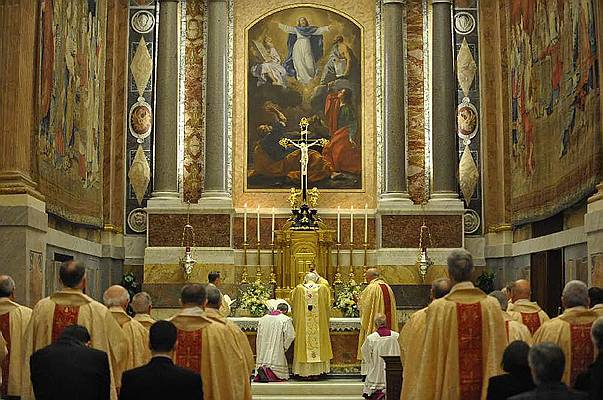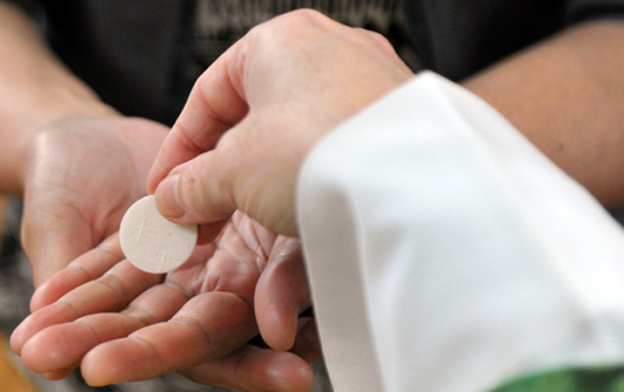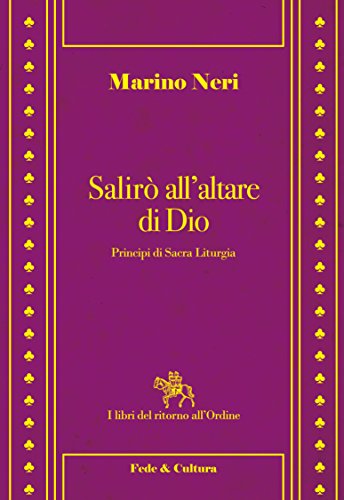Uwe Michael Lang
Le fait que le prêtre célèbre le plus souvent le sacrement de l’eucharistie face aux fidèles constitue l’un des changements les plus frappants qui ont affecté la liturgie catholique durant les dernières décennies. Cette évolution a été accompagnée de la mise en place d’autels isolés, ce qui a souvent entraîné dans des églises chargées d’histoire des travaux de transformation aussi radicaux que controversés. L’impression s’est installée — et pas seulement dans l’opinion publique interne à l’Eglise — que la position du célébrant versus populum lors de la messe était une obligation, et même que celle-ci avait été prescrite par la réforme de la liturgie lancée par le concile Vatican II. Or la lecture des documents du Concile et de l’après-Concile montre qu’il n’en est rien. Dans la constitution conciliaire sur la liturgie Sacrosanctum Concilium, il n’est question ni d’une célébration versus populum ni de la construction de nouveaux autels. Les règles liturgiques actuellement en vigueur considèrent comme souhaitable que l’autel principal d’une église soit élevé à une certaine distance du mur pour qu’il soit possible d’en faire le tour et afin qu’une célébration face au peuple soit possible. En aucun cas il n’est dit que l’orientation du prêtre vers le peuple doit être considérée toujours et partout comme la meilleure manière de célébrer la messe. De nombreuses personnes, dès les années soixante, ont exprimé un avis critique sur l’extension de ce mode de célébration versus populum. Aux côtés du liturgiste d’Innsbruck Josef Andreas Jungmann, s.j., et de l’oratorien français Louis Bouyer, on peut mentionner Joseph Ratzinger — qui était alors jeune théologien ayant participé au Concile et qui est depuis devenu le pape Benoît XVI.
L’orientation du célébrant face au peuple durant la totalité de la cérémonie eucharistique n’a dans les faits jamais été officiellement prescrite ni même introduite par la réforme liturgique. En général, les arguments tirés de l’histoire liturgique et invoqués en sa faveur sont la référence à la pratique liturgique présumée de l’Eglise des premiers temps. Les arguments proprement théologiques, quant à eux, sont dérivés de la notion de participatio actuosa, la «participation active» des croyants à la liturgie, telle que l’avait présentée le pape saint Pie X et qui a été placée au centre de la Constitution liturgique Sacrosanctum Concilium. Ces dernières années, une nouvelle approche critique a vu le jour; elle exige un approfondissement théologique de cette importante notion face à l’interprétation qui en a été donnée dans la période de l’après-Concile. On discute le fait que le vis-à-vis permanent du prêtre et des fidèles soit profitable à une véritable participation des croyants — telle qu’elle est exigée par le Concile Vatican II. Dans son livre fondamental sur L’Esprit de la liturgie, le cardinal Ratzinger faisait ainsi une distinction fondamentale entre liturgie de la Parole et liturgie eucharistique au sens strict: «L’aspect secondaire de ces actions extérieures devrait être clairement manifesté; l’évidence doit s’imposer: l’oratio ouvre l’espace à l’actio de Dieu. Et lorsque se déroule cette phase essentielle de la liturgie, lorsque commence la Prière eucharistique, toute activité doit cesser. Le comprendre, c’est comprendre qu’il n’est plus alors question d’observer ni même de regarder le prêtre, mais de contempler ensemble le Seigneur et d’aller à sa rencontre».
Dans ce même ouvrage, le cardinal Ratzinger soulignait également le caractère trinitaire de la liturgie: toute célébration de l’eucharistie est une prière adressée au Père par le Christ dans le Saint Esprit. Comment exprimer au mieux ce comportement intérieur dans les gestes liturgiques? Lorsque nous parlons avec quelqu’un, nous nous tournons naturellement vers cette personne. Cela vaut également pour les cérémonies liturgiques, qui impliquent que la prière du prêtre et des croyants soit orientée vers leur divin destinataire. Les expressions couramment employées «face au peuple» ou «dos au peuple» ne prennent d’ailleurs pas en considération celui à qui est adressée la prière et le sacrifice: le Seigneur.
En ce qui concerne la dimension historique de la question, il faut tout d’abord souligner que, dès les premiers temps, les chrétiens se tournaient vers l’Est, vers le soleil levant, pour prier. On considérait, tant pour la prière privée que pour la célébration liturgique, qu’on ne devait plus suivre l’ancien usage juif consistant à prier vers la Jérusalem terrestre mais qu’il fallait plutôt se tourner vers la nouvelle Jérusalem, la cité céleste, que le Seigneur ressuscité formera en rassemblant les rachetés, lorsqu’il reviendra pour juger le monde. Le soleil levant fut considéré par les premiers chrétiens comme une expression adéquate de l’espérance de la parousie, du retour du Christ dans sa gloire. L’orientation vers l’Est devint déterminante pour la liturgie et la construction des églises durant les siècles suivants. On considéra jusqu’à l’époque du bas moyen âge que les absides des églises et leurs autels devaient être orientés vers l’Est, lorsque cela, bien sûr, était possible. De cette manière, la symbolique cosmique de la messe revêtait une forme concrète.
Même dans les lieux où le face-à-face du prêtre et des fidèles était vraisemblablement la règle — pensons à certaines églises des premiers siècles dont l’entrée était orientée vers l’Est, en particulier à Rome et en Afrique du Nord —, le contact visuel n’existait pas, au moins lors de la Prière eucharistique, car tous priaient en levant les bras et en tournant leur regard vers le ciel. Dans l’Antiquité et à l’époque du haut moyen âge, il aurait semblé étrange d’associer une véritable participation de tous à l’action liturgique au fait de pouvoir observer les actions du célébrant. En tout cas, la célébration versus populum telle qu’elle est aujourd’hui comprise était inconnue de l’Antiquité chrétienne. Le fait de prendre comme exemple de cette manière de célébrer la pratique des basiliques romaines et leur orientation — comme celle de Saint-Pierre de Rome — serait un anachronisme.
L’orientation vers l’Est du prêtre et de la communauté lors de la liturgie eucharistique, dont l’usage dans l’histoire est très tôt attesté, n’est pas un hasard. Il ne s’agit pas seulement de la transmission d’une habitude mais d’une orientation consciente vers Dieu dans la prière, liée de manière étroite au sacrifice eucharistique. Mené par le prêtre, le peuple de Dieu en pèlerinage se met en prière devant le Seigneur. La préférence incontestable accordée à une orientation commune de la prière réside dans ce mouvement d’offrande collective, grâce auquel la dimension sacrificielle de l’eucharistie est mise en valeur. Par le Christ, nous présentons une prière et une offrande et, à la tête de la procession par laquelle s’exprime ce mouvement d’offrande (prosphora, oblatio) se trouve le prêtre, qui se dirige avec les fidèles vers le Seigneur. La thèse d’une relation objective entre le caractère sacrificiel de l’Eucharistie et l’orientation commune de la prière nécessiterait bien sûr une analyse détaillée mais elle est assez plausible. L’expérience pastorale des dernières décennies montre bien que ce lien existe: il est difficile de contester le fait que la célébration versus populum a été accompagnée d’une forte diminution de la compréhension de la messe comme représentation actuelle et offrande de l’unique sacrifice du Christ. Il ne s’agit pas de dire que l’orientation de la célébration est la seule cause de cette évolution. Mais chez les pionniers du mouvement liturgique du XXe siècle, le motif principal de l’introduction de la célébration versus populum consistait à rendre plus présente la compréhension, supposée oubliée, de l’eucharistie comme repas sacré. Force est de constater que cette dimension a été soulignée de manière unilatérale au détriment de l’affirmation que l’eucharistie est «un Sacrifice visible, tel que la nature des hommes le requérait». Bouyer voit dans l’opposition de la compréhension de l’eucharistie comme repas et comme offrande un dualisme artificiellement fabriqué, qui semble absurde aux yeux de la tradition liturgique. La catéchèse mystagogique, qui est sans aucun doute très importante, ne pourra rattraper cette perte aussi longtemps que le caractère sacrificiel de la messe ne trouvera pas son application correspondante dans la forme liturgique. En d’autres termes, tous les discours bien intentionnés sur le mystère de l’eucharistie, sacrifice du Christ et de l’Eglise, se perdent dans le lointain tant que, lors des célébrations, ils sont accompagnés de signes qui les contredisent.
Comme argument en faveur de la célébration «face au peuple», on dit souvent qu’elle est importante pour que le dialogue entre le prêtre et l’assemblée — il ne s’agit pas ici de contester le rôle de ce dialogue dans certaines parties de la liturgie — puisse avoir lieu. Mais le principe qui régit cet échange est le dialogue de tout le peuple rassemblé, clergé compris, avec Dieu. Le liturgiste français Marcel Metzger est allé jusqu’à dire que la célébration de la messe versus populum n’exprimait pas la forme véritable de l’Eglise et de l’office liturgique. Le prêtre ne célèbre pas l’eucharistie vers le peuple, mais c’est bien plutôt toute la communauté qui célèbre en étant tournée vers Dieu le Père, par Jésus-Christ dans le Saint Esprit. Ce dialogue de Dieu avec son peuple est mis en valeur de manière remarquable lorsque le célébrant est tourné vers l’abside. Puisque les hommes sont liés à l’espace et au temps, leurs prières et louanges adressées à Dieu s’actualisent dans des lieux concrets et des moments déterminés, «s’incarnent» en un sens. Pour Metzger l’orientation commune dans la prière est la plus haute expression de cette représentation spatiale de Dieu. Ce qui est important, ici, ce n’est pas l’orientation vers un lieu déterminé du ciel, mais l’explicitation sensible de la véritable forme de l’Eglise par l’orientation commune du prêtre et des fidèles, vers celui auquel ils adressent leur prière. En réponse à la banalisation et la désacralisation progressive de la vie liturgique, tout devrait être entrepris pour que soit donnée à la contemplation et à l’adoration du Seigneur la priorité absolue. Les prêtres sont les serviteurs humbles et discrets de ce mystère — ni plus, ni moins.
L’orientation commune de la prière dans la liturgie a été l’usage quasiment universel des églises latines jusqu’à une époque très récente. Elle continue d’être la règle dans les églises de tradition byzantine, syriaque, arménienne, copte et éthiopienne. La tradition liturgique et la pratique actuelle de toutes les églises orientales non catholiques et de la majorité des églises orientales catholiques connaissent cette orientation commune de la prière du prêtre et de l’assemblée, au moins lors de l’anaphore. Le fait que dans certaines églises orientales catholiques, surtout de la diaspora, ait été introduite la célébration face au peuple est dû à des influences occidentales de l’après-Concile. Cela représente pour ces églises un éloignement de leur tradition propre, par exemple chez les maronites et les syro-malabars. Il y a quelques années, la congrégation romaine responsable de ce sujet a indiqué de manière très claire que la célébration de la liturgie versus orientem représentait une tradition vivante, pleine de signification et transmise depuis les temps les plus reculés et qu’il importait de la conserver.
L’orientation commune vers Dieu, qui implique que tous soient tournés vers l’autel — que l’orientation vers l’Est soit réelle ou non — est donc la position la plus adéquate pour célébrer l’eucharistie au sens strict, en particulier le Canon. Ce n’est que lors des parties liturgiques en forme de dialogue, lors de la proclamation de la Parole et de la distribution de la communion, que le prêtre doit se tourner vers le peuple. Il n’est pas question d’évoquer ici dans le détail comment cette proposition pourrait être mise en pratique de manière concrète. Néanmoins la recommandation demeure: le prêtre devrait prier en étant tourné vers l’autel, surtout dans les églises anciennes où un autel majeur, dont la qualité esthétique est souvent importante, représente l’élément dominant de l’ensemble de l’espace. Les somptueux autels qui se trouvent dans les églises occidentales du moyen âge et de l’époque baroque, tout autant que les organisations absidiales du premier siècle encore conservées dans les églises byzantines et orientales, contribuent à honorer Dieu et rendre présente de manière sacramentelle, aux yeux des chrétiens rassemblés pour la prière et le sacrifice de la messe, l’œuvre de Rédemption par Lui accomplie. Car «l’autel est pour ainsi dire une ouverture dans le ciel; bien loin de fermer l’espace de l’église, il permet à la fois l’entrée de celui qui est l’Orient dans la communauté rassemblée et l’échappée de celle-ci hors de la prison de ce monde».
Article publié dans catholica.



